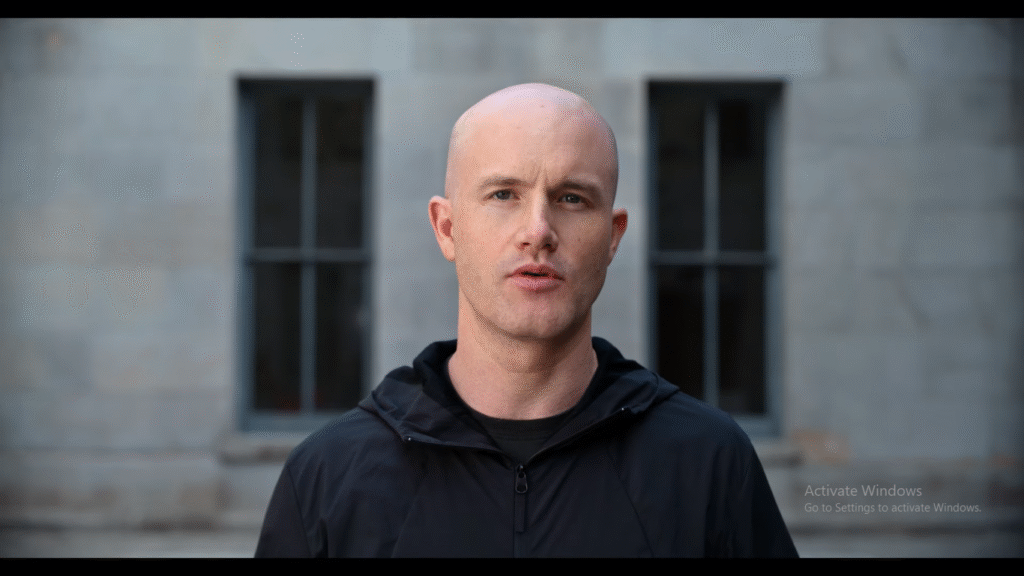Brian Armstrong’s Boldest Predictions for Crypto in 2025—Are They Coming True?

Follow Us On Social Media
Back in 2021, Brian Armstrong—CEO of Coinbase—made some seriously bold predictions about the future of crypto. From billion-user adoption to governments running on blockchain, his vision wasn’t just futuristic—it was ambitious.
Now that we’re in 2025, it’s time to pause and ask: How accurate were those predictions? Has crypto really gone mainstream? Are governments and banks being replaced by DeFi and DAOs?
Whether you’re just getting into crypto or curious about where things are headed, this blog breaks it all down. We’ll go through each of Armstrong’s major forecasts, look at real-world data from 2025, and see how closely his vision aligns with what’s actually happening today.
Let’s explore what came true, what’s still evolving, and what might have been a little too optimistic—while helping you learn how to navigate crypto safely as a beginner.
👨💼 Who Is Brian Armstrong?
Brian Armstrong is a name that carries weight in the world of crypto. As the co-founder and CEO of Coinbase, he’s played a massive role in bringing cryptocurrency to the mainstream. Coinbase was launched in 2012, back when Bitcoin was still considered fringe. Armstrong’s goal? Make crypto accessible, simple, and safe for everyone.
In 2021, Armstrong led Coinbase to become the first crypto company to go public on the NASDAQ. That IPO not only cemented his reputation as a visionary leader but also brought legitimacy to an industry still seen as risky by many.
Armstrong is known for being data-driven, calm under pressure, and focused on long-term adoption—not short-term gains. He avoids drama and hype, even when the rest of the crypto world is buzzing over the latest meme coin or celebrity endorsement.
What makes him stand out is his focus on financial inclusion. He’s repeatedly said that crypto is about giving people control over their money—especially in countries where banking systems fail or inflation is out of control. He believes crypto can unlock opportunity for billions, not just for the tech elite.
As a result, people take his predictions seriously. He isn’t making random guesses—his forecasts come from deep experience, access to user data from Coinbase, and conversations with policymakers around the world.
🔍 His Top Predictions Revealed

Brian Armstrong has never been shy about sharing bold ideas about crypto’s future. Over the last few years, he’s made several predictions that reflect his belief in crypto’s potential to change the financial system.
Here are five of his most talked-about predictions:
1. 1 Billion Crypto Users by 2030
Armstrong predicted that crypto would become as widespread as mobile internet or smartphones. He envisioned over 1 billion users using crypto by the end of the decade.
✅ Reality Check (2025): We’re at 690 million users globally, according to Crypto.com. That’s up from around 420 million in 2023—showing we’re on track to hit that billion-user milestone.
2. Most Startups Will Be DAOs
He believed that traditional companies would be replaced by DAOs—Decentralized Autonomous Organizations—governed by code and token holders, not CEOs and boards.
⏳ Reality Check (2025): DAOs are growing in the Web3 space. They’re used to manage DeFi protocols, gaming guilds, and even media brands. But legal uncertainty keeps most startups from becoming DAOs. For now, they remain a niche but growing part of the startup scene.
3. DeFi Will Overtake Traditional Finance
Armstrong saw decentralized finance (DeFi) as a major disruptor of banks and financial institutions.
✅ Reality Check (2025): DeFi is booming. Platforms like Uniswap, Aave, and Curve now handle over $195 billion in value. While banks still dominate for mortgages and large loans, DeFi is winning in global lending, yield generation, and decentralized exchanges.
4. Crypto Will Replace Remittance Services
He said crypto would transform how people send money across borders—especially in developing countries.
✅ Reality Check (2025): He was right. Strike, RippleNet, and stablecoin apps are now handling over 35% of remittances in regions like Latin America and Southeast Asia. Transactions settle instantly, and fees are under 1%.
5. Governments Will Adopt Crypto Infrastructure
Armstrong envisioned governments using blockchains for everything from IDs to voting.
❌ Reality Check (2025): It’s happening slowly. Over 20 countries are testing CBDCs, but full blockchain integration is still rare. Estonia and Nigeria lead in using blockchain for digital records, but most governments are still hesitant.
Explore one more crypto entrepreneur Bio , Here – Kain Warwick Biography: Building a Billion-Dollar DeFi Empire
📊 What’s Actually Coming True?
Let’s compare what Armstrong predicted vs. what’s actually happening in 2025.
| Prediction | Status in 2025 |
|---|---|
| 1 Billion Users | 🚀 690M users and growing |
| DAOs Replace Startups | ⚖️ Still niche, slowly growing |
| DeFi Overtakes Banks | 📈 Massive growth, still early |
| Crypto for Remittance | 💸 Game-changer in developing countries |
| Government Blockchain Use | 🕰️ Still in pilot mode |
While not everything has come true, Armstrong’s predictions were directionally correct. Crypto adoption is growing rapidly, particularly outside of the U.S. DeFi is now mainstream among crypto users, and remittance apps using crypto rails are making a real impact in the developing world.
What’s lagging? Government adoption. CBDCs are mostly in test phases, and bureaucracy has slowed down implementation of blockchain infrastructure. Still, Armstrong didn’t expect everything to happen overnight—his forecasts were long-term.
What’s clear is this: Armstrong saw where things were going and, for the most part, he wasn’t wrong.
🧠 Why Do People Trust Brian Armstrong?

Trust in crypto is hard to earn. Between rug pulls, scams, and vaporware, it’s easy for newcomers to feel overwhelmed. But Brian Armstrong has built a reputation as one of the most trustworthy voices in the space.
So, what sets him apart?
✅ He runs Coinbase, a public company with regulatory scrutiny. Unlike anonymous influencers or startup founders, Armstrong has to back his words with real accountability.
✅ He’s not here for hype. Armstrong avoids get-rich-quick narratives. He often reminds people that crypto is a long-term shift in how we interact with money—not just a way to make fast profits.
✅ He speaks clearly and transparently. Through blog posts, Twitter threads, and public interviews, Armstrong often explains complex topics in a calm, factual way. That helps beginners understand—and trust—his perspective.
✅ He promotes responsible innovation. Rather than fighting regulation, Armstrong has worked with U.S. lawmakers to build a legal framework for crypto. His aim is to create a system where innovation can thrive without harming consumers.
And most importantly, Armstrong’s vision is inclusive. He wants crypto to reach people in countries with broken financial systems, not just rich Western investors. That long-term mission—giving financial freedom to everyone—is why millions continue to listen to what he says.
🔒 How to Choose Safely as a Beginner

If you’re new to crypto, Brian Armstrong’s optimism might inspire you—but don’t confuse inspiration with investment advice. It’s important to explore safely and build knowledge as you go.
Here’s how to stay safe:
1. Stick with Regulated Platforms
Start with exchanges that are legally registered and have a strong reputation:
- Coinbase
- Kraken
- Bitstamp
Avoid unknown or offshore platforms with limited oversight—they’re riskier for beginners.
2. Start Small and Learn First
Don’t invest everything at once. Begin with small amounts of Bitcoin, Ethereum, or USDC, and learn how wallets, seed phrases, and transactions work.
Platforms like Coinbase Learn or beginner tutorials on CryptoTrendd are great for hands-on learning.
3. Avoid Scams That Piggyback on Predictions
Scammers often misuse names like “Brian Armstrong” or “Vitalik Buterin” to sell fake tokens. If it says:
“Earn 25% APY with zero risk! Click here!”
…it’s probably a scam. Always verify through official sources and double-check URLs.
You should also read this blog – Noah Dummett: 10 Fascinating Insights into His Life
📈 How to Use His Vision to Plan Ahead

You don’t need to be a developer or crypto pro to apply Brian Armstrong’s insights. Even as a beginner, you can use his vision to shape your own crypto journey.
Here’s how:
- Focus on real use cases. Armstrong talks about crypto in practical terms—like remittances, DeFi lending, and decentralized identity. Explore the tools that solve real-world problems.
- Think long-term. Armstrong emphasizes the 10-year outlook, not day-to-day price charts. Make small investments you’re comfortable holding for years.
- Follow the builders. Read updates from platforms like Coinbase Blog, CryptoTrendd, and Messari. You’ll learn more by following developers than hype influencers.
- Diversify smartly. Once you understand the basics, explore staking, stablecoins, and new protocols gradually—don’t dive into 20 tokens all at once.
By following these steps, you can make informed decisions without needing to predict the next big thing.
👥 Real User Stories (2025)
📍Case Study 1: Maria (Philippines)
Maria sends money home to her family from Dubai every month. In 2023, she used Western Union and paid 7–10% in fees. Now, in 2025, she uses Strike on Bitcoin’s Lightning Network and pays less than 1%. Funds arrive instantly—no middlemen, no delays.
“Crypto helps me send more to my family without wasting it on fees. I just wish I found this earlier.”
📍Case Study 2: Jacob (Kenya)
Jacob is a freelance web designer paid in USDC through Coinbase Wallet. With limited access to local banks, crypto gives him direct financial freedom.
“I don’t need a bank anymore. I get paid in stablecoins, save in Ethereum, and even earn yield through DeFi. This changed everything for me.”
💬 My Take: Is Armstrong’s Crypto Vision Still Relevant?
From my perspective, Brian Armstrong’s predictions were bold—but mostly grounded in reality. As someone who follows crypto daily, I’ve seen a lot of noise, hype, and broken promises. But Armstrong’s ideas? They age well.
He didn’t chase memes or make flashy statements. Instead, he focused on long-term infrastructure—wallets, regulation, user safety, financial inclusion. And now in 2025, a lot of what he said is starting to unfold, especially outside the U.S. where people truly need better financial systems.
While I don’t think DAOs will replace every startup just yet, I do believe DeFi and cross-border payments are changing lives faster than most people realize.
If you’re a beginner, Brian Armstrong’s approach is a good one to follow: learn first, invest later—and think years, not weeks.
Do you know Jesse Pollak journey ? Here this full blog – Jesse Pollak Biography: From Clef to Building Base at Coinbase
🔗 Connect with Brian Armstrong Online
Want to dive deeper into Brian Armstrong’s thoughts, predictions, and updates? Follow him across his official social platforms:
🐦 Twitter (X)
👉 @brian_armstrong – Where he shares bold takes on crypto, tech, and the future of finance.
👉 Brian Armstrong on LinkedIn – Professional insights and leadership updates.
✍️ Medium
👉 Brian’s Blog on Medium – In-depth posts on decentralization, crypto innovation, and personal vision.
📸 Instagram (less active)
👉 @brianarmstrong – Occasional glimpses into his life and work.
📰 Coinbase Blog
👉 Coinbase Official Blog – Stay updated on the latest from the company he leads.
✅ Final Thoughts
Brian Armstrong may not have predicted everything perfectly—but many of his ideas have come true or are well on their way. From the rise of DeFi to the growing use of crypto in global remittances, his vision is shaping how the crypto world evolves.
As a beginner, you don’t have to follow every prediction blindly. Instead, learn from Armstrong’s approach: stay calm, think long-term, and build your knowledge slowly.
Crypto can be overwhelming, but with the right mindset and resources, you’ll find your footing. And remember—you’re still early.
❓ FAQs About Brian Armstrong’s Predictions & Crypto Safety
Q1. Are Brian Armstrong’s predictions financial advice?
👉 No. His predictions are insights based on trends. Always DYOR (Do Your Own Research) before investing.
Q2. Is Coinbase still safe to use in 2025?
✅ Yes. Coinbase remains a publicly listed company, regulated in the U.S., and widely considered a secure exchange for beginners.
Q3. What is a DAO, and do I need to join one?
🧾 A DAO is a decentralized organization managed by smart contracts and voting. You don’t need to join one—but if you’re active in Web3, it’s worth exploring.
Q4. Can crypto really replace banks?
🪙 In some areas—yes. Especially for remittances, lending, and cross-border payments. But banks still play a big role, especially in mortgages and large-scale finance.
Q5. How do I start with crypto if I’m a beginner?
🔰 Start small. Open an account on a regulated exchange (like Coinbase or Kraken), buy a little Bitcoin or Ethereum, and learn through free resources. Bookmark trusted blogs like CryptoTrendd.
🚀 Explore the People & Platforms Powering Crypto’s Future
Inspired by Brian Armstrong’s vision? You’re just getting started. At CryptoTrendd, we break down the best crypto trading apps and spotlight the entrepreneurs shaping the next wave of Web3.
Where to go next:
📱 Top Crypto Trading Apps of 2025
Compare features, security, and fees across the top platforms.
👤 Crypto Founder Stories
Learn how pioneers like Armstrong, Yakovenko (Solana), and Jesse Pollak (Base) built billion-dollar platforms.
📊 Crypto App Reviews
Get honest, beginner-friendly reviews of trending apps—from Edge Wallet to BitGlide.
🧠 How to Start as a Crypto Entrepreneur
Thinking of building your own app or tool? Start with insights from real founders.
Whether you’re trading, learning, or building—CryptoTrendd helps you stay ahead with real, trusted insights.
👉 Explore More Tools | Read Founder Bios | Compare Crypto Apps
Follow Us On Social Media

3 Comments